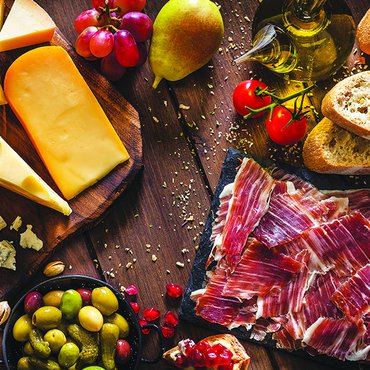KeHE Foods on Monday unveiled 10 macro trends to watch in the retail food industry in 2022, based on the developments of the past year as well as the distributor’s observations around product innovation, consumer trends, and industry shifts.
The trends include ongoing shifts toward plant-based, functional, sustainable, and locally-sourced foods, as well as foods from African and Mediterranean cuisines, non-alcoholic drinks for the sober-curious, and convenient meal and snack solutions.
The 10 macro trends for retailers to watch in the coming year, according to KeHE, are:
• Food adventuring. “Cuisine exploration is on the rise as consumers look to travel the world through their taste buds with newer trending flavors like yuzu, hibiscus, ube, and tzatziki,” KeHE said. Younger consumers in particular are driving exploration of cuisines from Africa and Mediterranean regions, KeHE said. Read more about North African cuisines here.
• Food tech boom. Technology will drive innovations in plant-based, ready-to-eat meat alternatives, egg substitutes, and sweeteners, as consumers demand simpler and “real” ingredients from brands, KeHE said. Look for an increase in demand for allulose as a sugar replacement, KeHE said, and new categories created using food technologies.
• Sober-curious. An increasing number of consumers, particularly younger consumers, are abstaining from alcohol and choosing alcohol-free beverages. “The rise of this trend stems from the cultural dominance of mindfulness, legalization of alternatives to alcohol, deepening health and wellness understandings, along with shifting spaces of consumption and ways of socialization,” said KeHE. The distributor cited research showing that 31 percent of adults over the age of 22 consumed an alcoholic beverage less than once per month or not at all over the last three months, and 24 percent of Gen Zers saying they do not drink alcohol often or at all when dining out because of health reasons. More about the sober-curious trend here.
• Dual purpose. This trend refers to the fact that food not only has to taste good, but also has to be as sustainable as possible. “[Consumers] are looking for upcycled, zero waste, reduced carbon footprint, and water reduction in the products they purchase,” KeHE said. While still emerging as a trend, consumers are also looking at farming practices, looking at regenerative agriculture – the practice of increasing soil biodiversity and organic matter, leading to more resilient soil that can better withstand climate change impacts without the need for synthetic fertilizers and/or pesticides. More about launching a sustainable food brand here.
• Convenience continues. Meal solutions that make it easy for consumers to prepare food for themselves and their families at home gained considerable traction during the pandemic, and remain popular with consumers. According to KeHE, 53 percent of U.S. consumers who cooked using convenience foods and followed set meal routines during the pandemic plan to continue these routines. In addition to time-saving meal prep items, these consumers will also look for grab-and-go snacks. “Chef-inspired frozen meals, home delivery meals, and refrigerated appetizers and entrees are expected to continue in growth as consumers look for quick lunches or dinners to be made at home or away from home,” KeHE said.
• Blurring diet lines. Consumers have become more proactive about maintaining their health, and are picking and choosing from various diet fads, and customizing them to suit their own personal needs. For example, consumers may choose to eat more of a flexitarian diet with less meat and more plants rather than committing to becoming a vegan or vegetarian. “This holds true for other popular diets like Keto as well, choosing ‘lower carb’ over ‘low carb,’” KeHE said.
• Permissible indulgence. The definition of snacking is evolving. Shoppers are seeking guilt-free indulgent treats by reading ingredient and nutritional callouts that make an item both decadent and healthy. “In fact, 69 percent of consumers say they want the best of both worlds, looking for snacks to balance health and taste,” KeHE said.
• Growing your local community. The “buy local” movement had been growing in grocery stores before the pandemic, but consumers have embraced it to a greater degree during the past two years both to support their communities and in part because of supply issues for national brands. Nearly two-thirds (65 percent) of Americans try to buy from local companies when possible, and one in three millennials say purchasing local is a top priority for them, according to KeHE. “By adding in local vendors and drawing attention to those products using signage and shelf tags, stores can build a sense of unity and pride for their shoppers,” KeHE said.
• Getting grain-ular. Oats offer an affordable source of nutrition and have been appearing in more and more products, most notably as a non-dairy milk substitute but also as an ingredient in refrigerated and frozen desserts, cheese, butter, spreads, and even oat protein. “While consumers are going oat-crazy, other grain innovation has entered the market,” KeHE said. The company predicts the rise of barley, hemp, pistachio, and buckwheat as future grain, seed, and nut alternatives.
• Functionality collab. Pressured by inflation and supply chain shortages, consumers are increasingly looking to get the most out of their food and beverages, KeHE said. This has led shoppers to seek out more functional attributes in everyday products. “Ingredients that are found to be naturally beneficial or boost immunity are now being found in new category segments,” KeHE said, citing the example of mushrooms entering the beverage, coffee, creamer and snacking categories.
Related: Specialty Food Association Trendspotter Panel Reveals What’s Hot for 2022; Retailer Q&A: Dying Trends.

